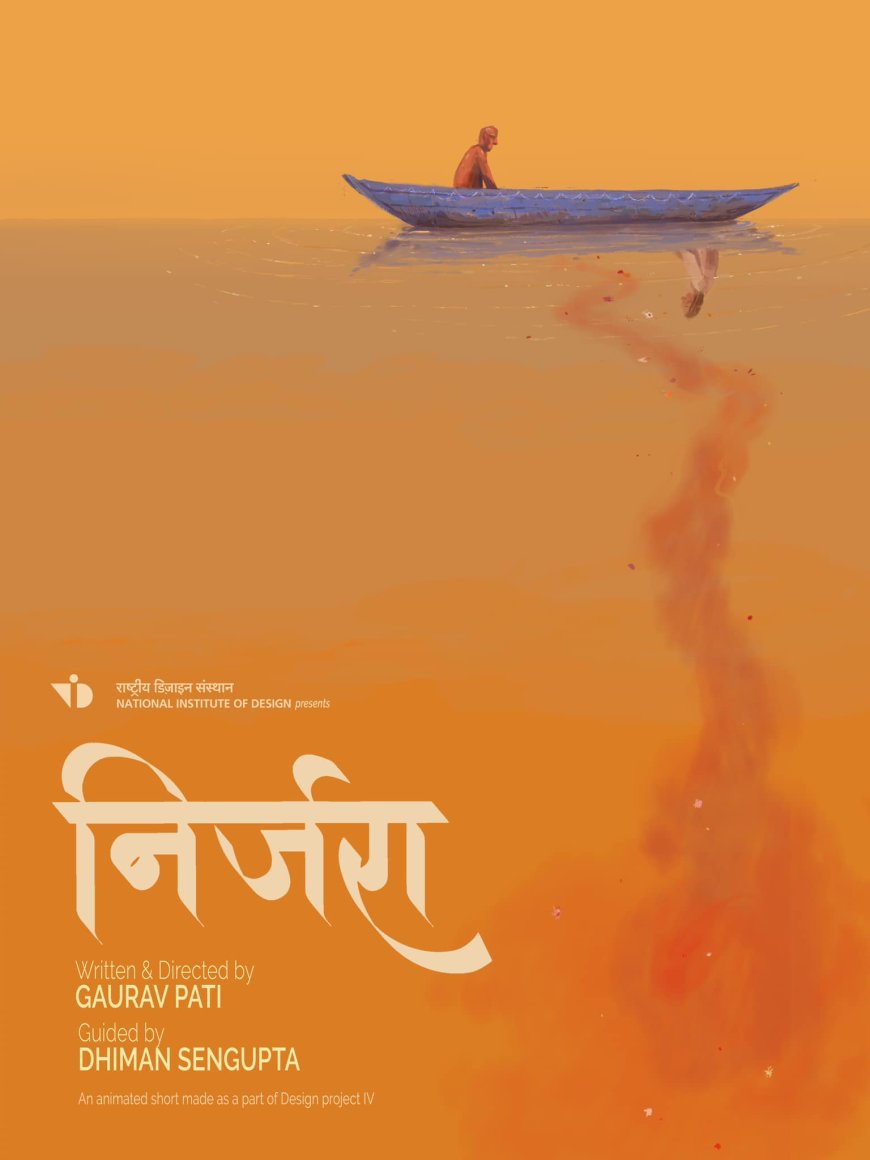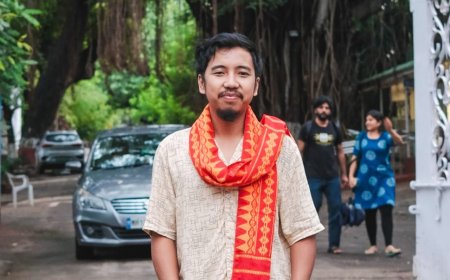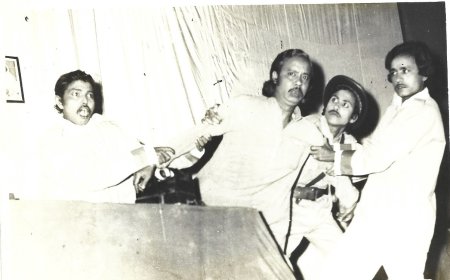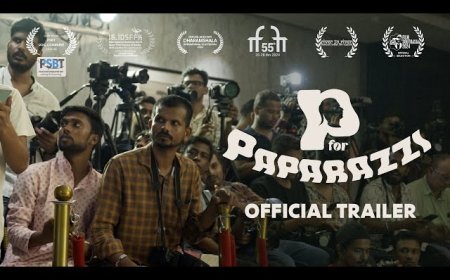An interview with the filmmaker of Nirjara (2023) Gaurav Pati
Dipankar Sarkar provides a interview based review of the film Nirjara.

Gaurav Pati's animation short film Nirjara (2023) is the tale of two brothers, Aniket and Venkat, and how they negotiate their relationship amidst the hierarchy prevalent in the structure of Indian families. When their mother dies, the ghat of. Varanasi, where the last rites are to be performed, becomes a catalyst for the brothers to re-evaluate their bond.
Nirjara won the Silver Conch for the Best Animation Film at MIFF 2024.
In this interview, Pati speaks about his student life at the National Institute of Design (NID), the conceptualization of his animation short film, and the importance of gaining recognition.
What inspired you to choose a career in animation filmmaking?
It began early, when I didn’t know how to tell a story, but I knew how to draw one. In conversation with my mother, she recalls me buying notepads and drawing a story one page after the other while talking to myself. I was always interested in sequences. To this day, stories are visual patterns—each story a unique pattern in space—something like an embroidery or a constellation. This progression of a story, one drawing at a time, is what fascinated me the most growing up; down the line, I characterize this practice as a naïve attempt at storyboarding. This led to my discovery of graphic narratives; around fourteen was when I picked up on the medium and started reading the classics. It happened to be my first outlet for visual storytelling. My early attempts garnered me praise and gave me the courage to write more. Baby steps at a time, they say.
Films, on the other hand, came rather late to me. Our family didn’t have any film buffs; I grew up with books around me, and the cable television was out of service because it rarely was of any use. I seriously understood cinema only after joining NID. I felt this deep connection to the medium in my time here, where I was introduced to techniques and auteurs and, of course, animation films—the kind I hadn’t fathomed the existence of. Be it Kon’s dreamscape or Yamamura’s brilliance, as I was exposed more and more to amazing works of animation, my love for the medium kept growing.
How fruitful was it to study at National Institute of Design, Ahmedabad?
I owe it immensely to my time at this institute. It would be an understatement to say that my world has changed here. Coming from years of academic rigor, I felt relieved to be in a place that valued my artistry. I felt happy to be around people who mirrored my appreciation for the craft. In addition to that, I wholeheartedly cherish the competition that came along—to wake up every day and strive to be better at something one loves is indeed a privilege. NID is a place where you will find students from every corner of the country. Multi-culturalism makes the education here special; it made me dig deeper and embrace my roots as an Indian artist above anything else. To most, it might seem trivial, but it is these small things that make the difference. It’s not always skill-based training or infrastructure, but a deep understanding of culture and identity that breeds great artists. And in my time at NID, this was something I believe I worked towards through my assignments and explorations.
I would like to express my gratitude to the institution, the faculty members who guided me along the way, the animation department, and especially Dhiman Sengupta, who was my guide on this project. It was under his mentorship, guidance, and criticism that I unlocked my potential as an artist and produced this film.
Given that films have been made on performing the rituals of death on the ghats of Ganga, what sort of uniqueness did you decide to add while scripting for Nirjara?
I can say this with certainty: I did not walk into this film. It is a product of rewrites and discussions with my guide over months, followed by more rewrites. It took a lot of this for the story to evolve into what it is now; in fact, if I were to go back to the earlier drafts, there is no mention of Banaras or the ghats. Although the story thematically tackled loss, the setting was very different. This is because the story is never about a mother’s death or the ghats; it is about the brothers as they battle this loss and question their position in these societal norms and hierarchies. The whole concept of the ghat being this place of shared pain and animosity for the brothers only came into existence later on.
I had the pleasure of witnessing the ghats in person a few years ago. And it’s the experiences from there that made their way into the story and allowed me to capture the persona of this place. Be it the hustle and bustle of the late evening at the ghats, which I tried capturing in the tracking shot, or the Ganga aarti that lights up the bank in vibrant colors, all of these unique experiences translated into the film in one way or another.
At the conceptual stage, what colour schemes did you have in mind to showcase the conflict and loss within the story?
Colours are something I try my best not to break my head over until the scripting is finished, but that is easier said than done, so I jot down keywords on the side of the page sometimes to keep a note. It is during the shot breakdown that I start focusing on the visuals. Many times, the exact colours that I end up liking come about by accident. It is not as if I am very calculative with my colour scripts, trying to pin down shades with regard to set emotions, but I do give it a lot of thought. At the end of the day, it all depends on what the visual style demands. In the case of Nirjara, I preferred saturated flat tones but a very limited palette in most shots. What I felt was crucial was fixing the time of day for each scene—that reflected the emotional state and helped me pick the right colours. For instance, choosing to depict the Asthi Visarjan at sundown was a choice made while keeping the colours in mind. The strong yellows giving off this dizzying warmth, coupled with the burning pyres in the back, emanated such intense feelings.
The dead mother, the bindi, and the crescent-shaped moon—what was their symbolic reference?
I like to leave a lot to interpretation because, many times, these symbols tend to find themselves and fall into patterns. Good storytelling is the product of the subconscious, and it should at times surprise the artist too! This play on the bindi was something that manifested in the final draft and tied down the whole story beautifully. My initial intent with it was rather straightforward: Tikli, as it is called back home, is the symbol of motherhood across India. It is a prominent cultural element that speaks of maternal love and warmth. When Aniket sees his mother on the pyre without the bindi, it is a striking moment of loss for him; she feels empty to him. Throughout the rest of the film, he battles this notion of emptiness, believing that his brother is too good to feel the same. The animosity of familial hierarchy returns to an end, and the trauma on each side resurfaces with the departure of the only person who held this ship together. As the story progresses, we see this slowly dissolve—an understanding is born, the family remains, but with a huge chunk gone now, what is left is like the crescent moon, shining brilliantly in the night sky, reminiscent of her soul that lives on.
Did taking a dip in the holy river help the two brothers wash away the bitterness of the past and signal a purification towards a renewed relationship?
Yes, it is a moment of mutual understanding. Tense moments in life tend to cloud our thinking; after all, we are emotional beings. Submerged in the cold waters of Ganga, the brothers look eye-to-eye for the first time in the film. The pain is the same; they just choose to feel it differently. At times, the effect that familial hierarchy has on individuals is really deeply rooted in the psyche. While Venkat, the elder brother, feels the need to hold together the family and act as a pillar of strength, this makes Aniket feel left out and invisible given his experiences of the past. He is often seen as the younger and more immature one. At the end, when all is said and done, the brothers stand shoulder to shoulder, just as their mother would have liked it to be.
Why did you decide to end the film with Bhajan Ram Niranjan Nyaraa Re Kabir by Kumar Gandharva?
This song has always been special to me; it is powerful, ethereal, and everything a divine hymn is supposed to be. I usually create a musical palette while working on a film since I enjoy stumbling upon or recalling music that fits the script perfectly. It gives me new ideas and furthers the writing process. This Bhajan by the Great Kumra Gandharva was on loop throughout the creation process, and it felt like the perfect song to conclude the film with. Submerged in the sacred waters, surrounded by diyas—each kindled with care and prayer. In the backdrop of a lit ghat, as the Ganga aarti echos into the night, if this doesn’t remind you of this song, what else does?
How important was it to win the Silver Conch for the Best Animation Film at MIFF 2024?
It means so much to me! I was elated upon receiving the news that my film ‘Nirjara’ won the Silver Conch Award for ‘Best Animation Film’ at the Mumbai International Film Festival 2024. This film is extremely close to me, and I have always believed in it, and with this award, my belief is even stronger. The film is nearing the end of its festival run, gaining traction at multiple festivals nationally and internationally over the past months. To name a few, it won Best Story, represented India at the Digicon 6Asia Awards in Japan, won the runner-up award at the Animfantasia Student Film Festival in Romania, and was a finalist at the Silk Road International Film Festival in Turkey. The MIFF recognition has come at a perfect time since the film will soon complete its one year journey around festivals. I would like to thank the jury and the organizers of MIFF for this honour, and everyone for showing so much love to my debut film.
*****
What's Your Reaction?


































































